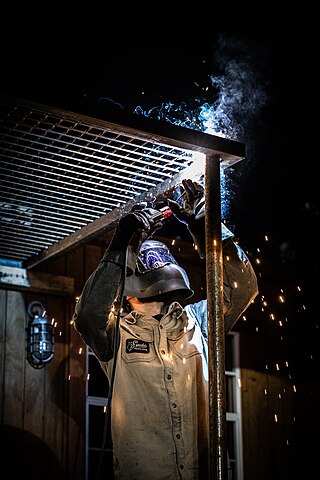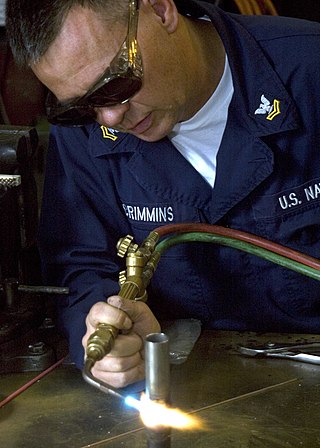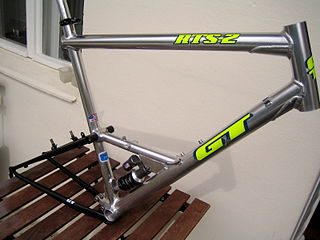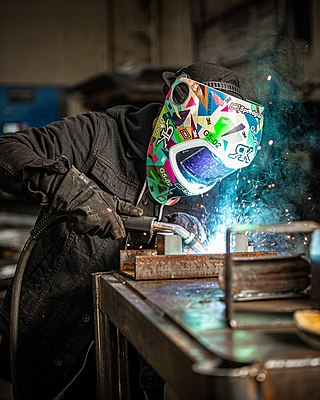Related Research Articles

Welding is a fabrication process that joins materials, usually metals or thermoplastics, primarily by using high temperature to melt the parts together and allow them to cool, causing fusion. Common alternative methods include solvent welding using chemicals to melt materials being bonded without heat, and solid-state welding processes which bond without melting, such as pressure, cold welding, and diffusion bonding.

Submerged arc welding (SAW) is a common arc welding process. The first SAW patent was taken out in 1935. The process requires a continuously fed consumable solid or tubular electrode. The molten weld and the arc zone are protected from atmospheric contamination by being "submerged" under a blanket of granular fusible flux consisting of lime, silica, manganese oxide, calcium fluoride, and other compounds. When molten, the flux becomes conductive, and provides a current path between the electrode and the work. This thick layer of flux completely covers the molten metal thus preventing spatter and sparks as well as suppressing the intense ultraviolet radiation and fumes that are a part of the shielded metal arc welding (SMAW) process.

Brazing is a metal-joining process in which two or more metal items are joined by melting and flowing a filler metal into the joint, with the filler metal having a lower melting point than the adjoining metal.
Aluminium–silicon alloys or Silumin is a general name for a group of lightweight, high-strength aluminium alloys based on an aluminum–silicon system (AlSi) that consist predominantly of aluminum - with silicon as the quantitatively most important alloying element. Pure AlSi alloys cannot be hardened, the commonly used alloys AlSiCu and AlSiMg can be hardened. The hardening mechanism corresponds to that of AlCu and AlMgSi.
Flux-cored arc welding is a semi-automatic or automatic arc welding process. FCAW requires a continuously-fed consumable tubular electrode containing a flux and a constant-voltage or, less commonly, a constant-current welding power supply. An externally supplied shielding gas is sometimes used, but often the flux itself is relied upon to generate the necessary protection from the atmosphere, producing both gaseous protection and liquid slag protecting the weld.

Gas tungsten arc welding is an arc welding process that uses a non-consumable tungsten electrode to produce the weld. The weld area and electrode are protected from oxidation or other atmospheric contamination by an inert shielding gas. A filler metal is normally used, though some welds, known as 'autogenous welds', or 'fusion welds' do not require it. A constant-current welding power supply produces electrical energy, which is conducted across the arc through a column of highly ionized gas and metal vapors known as a plasma.

Plasma arc welding (PAW) is an arc welding process similar to gas tungsten arc welding (GTAW). The electric arc is formed between an electrode and the workpiece. The key difference from GTAW is that in PAW, the electrode is positioned within the body of the torch, so the plasma arc is separated from the shielding gas envelope. The plasma is then forced through a fine-bore copper nozzle which constricts the arc and the plasma exits the orifice at high velocities and a temperature approaching 28,000 °C (50,000 °F) or higher.
Shielding gases are inert or semi-inert gases that are commonly used in several welding processes, most notably gas metal arc welding and gas tungsten arc welding. Their purpose is to protect the weld area from oxygen, and water vapour. Depending on the materials being welded, these atmospheric gases can reduce the quality of the weld or make the welding more difficult. Other arc welding processes use alternative methods of protecting the weld from the atmosphere as well – shielded metal arc welding, for example, uses an electrode covered in a flux that produces carbon dioxide when consumed, a semi-inert gas that is an acceptable shielding gas for welding steel.
In metalworking, a filler metal is a metal added in the making of a joint through welding, brazing, or soldering.

An aluminium alloy (UK/IUPAC) or aluminum alloy is an alloy in which aluminium (Al) is the predominant metal. The typical alloying elements are copper, magnesium, manganese, silicon, tin, nickel and zinc. There are two principal classifications, namely casting alloys and wrought alloys, both of which are further subdivided into the categories heat-treatable and non-heat-treatable. About 85% of aluminium is used for wrought products, for example rolled plate, foils and extrusions. Cast aluminium alloys yield cost-effective products due to the low melting point, although they generally have lower tensile strengths than wrought alloys. The most important cast aluminium alloy system is Al–Si, where the high levels of silicon (4–13%) contribute to give good casting characteristics. Aluminium alloys are widely used in engineering structures and components where light weight or corrosion resistance is required.
6061 aluminium alloy is a precipitation-hardened aluminium alloy, containing magnesium and silicon as its major alloying elements. Originally called "Alloy 61S", it was developed in 1935. It has good mechanical properties, exhibits good weldability, and is very commonly extruded. It is one of the most common alloys of aluminium for general-purpose use.
7075 aluminium alloy (AA7075) is an aluminium alloy with zinc as the primary alloying element. It has excellent mechanical properties and exhibits good ductility, high strength, toughness, and good resistance to fatigue. It is more susceptible to embrittlement than many other aluminium alloys because of microsegregation, but has significantly better corrosion resistance than the alloys from the 2000 series. It is one of the most commonly used aluminium alloys for highly stressed structural applications and has been extensively used in aircraft structural parts.
5086 aluminium alloy is an aluminium–magnesium alloy, primarily alloyed with magnesium. It is not strengthened by heat treatment, instead becoming stronger due to strain hardening, or cold mechanical working of the material.
5083 aluminium alloy is an aluminium–magnesium alloy with magnesium and traces of manganese and chromium. It is highly resistant to attack by seawater and industrial chemicals.
AA 2319 is an aluminium alloy principally containing copper (5.8–6.8%) as an alloying element. It also contains ≤0.20% silicon, ≤0.30% iron, 0.20–0.40% manganese, ≤0.02% magnesium, ≤0.10% zinc, 0.10–0.20% titanium, 0.05–0.15% vanadium, 0.10–0.25% zirconium, ≤0.0003% beryllium and up to 0.15% trace elements. The density of 2319 aluminium is 2840 kg/m3. This alloy was first registered in 1958, in the United States.

Gas metal arc welding (GMAW), sometimes referred to by its subtypes metal inert gas (MIG) and metal active gas (MAG) is a welding process in which an electric arc forms between a consumable MIG wire electrode and the workpiece metal(s), which heats the workpiece metal(s), causing them to fuse. Along with the wire electrode, a shielding gas feeds through the welding gun, which shields the process from atmospheric contamination.
5356 aluminium alloy is an alloy in the wrought aluminium-magnesium family. Unlike most aluminium-magnesium alloys, it is primarily used as welding filler. It is one of the most popular aluminium filler alloys, alongside 4043. It possesses relatively high strength, but at the expense of being more vulnerable to cracking. It is the preferred filler when making lap or butt welds on the popular 6061 aluminium alloy, or when the welded parts are to be anodized.
2195 aluminium alloy is an alloy in the wrought aluminium-copper family. It is one of the Weldalite family of Aluminium–lithium alloys. It is one of the most complex grades in the 2000 series, with at least 91.9% aluminium by weight. 2195 aluminium can be alternately referred to by the UNS designation A92195.
voestalpine Böhler Welding is a manufacturer of welding consumables, welding equipment and accessories with headquarters in Düsseldorf. The company owns over 50 subsidiaries in more than 25 countries, 2,300 employees, customers in approximately 150 countries and more than 1,000 distribution partners.
Aluminium 7050 alloy is a heat treatable alloy. It has high toughness, high strength. It has high stress corrosion cracking resistance. It has electric conductivity of value having 40 percent of copper. 7050 aluminium is known as a commercial aerospace alloy.
References
- ↑ "Alloy 4043/ Aluminium Welding Alloy 4043". www.aircraftmaterials.com. Retrieved 2019-05-18.
- ↑ "Aluminum 4043 Alloy (UNS A94043)". AZoM.com. 2013-05-02. Retrieved 2019-05-18.
- ↑ "Alloy 4043 (MIG) | The Harris Products Group". www.harrisproductsgroup.com. Retrieved 2019-05-18.
- 1 2 Ortega, Arturo Gomez; Galvan, Luis Corona; Salem, Mehdi; Moussaoui, Kamel; Segonds, Stéphane; Rouquette, Sébastien; Deschaux-Beaume, Frédéric (2019). "Characterisation of 4043 aluminium alloy deposits obtained by wire and arc additive manufacturing using a Cold Metal Transfer process". Science and Technology of Welding and Joining. 24 (6): 538–547. doi: 10.1080/13621718.2018.1564986 . ISSN 1362-1718.
- ↑ "eFunda: Properties of Aluminum Alloy AA 4043". www.efunda.com. Retrieved 2019-05-18.
- ↑ "Aluminum Workshop: Using 4043 versus 4047 filler wire". www.thefabricator.com. Retrieved 2019-05-18.
- ↑ "ALLOY 4043 WELD DATA SHEET" (PDF).
- ↑ "Should I use 4043 or 5356 filler alloy?". www.esabna.com. Retrieved 2019-05-18.
- ↑ "Aluminum 4043-O". www.matweb.com. Retrieved 2019-05-18.
- ↑ "Aluminum 4043-H18". www.matweb.com. Retrieved 2019-05-18.